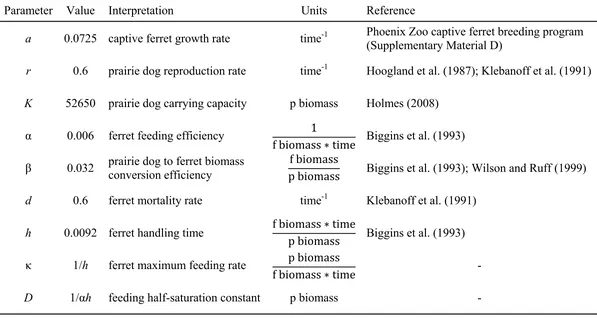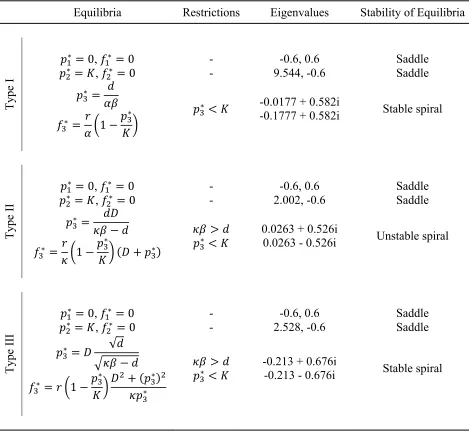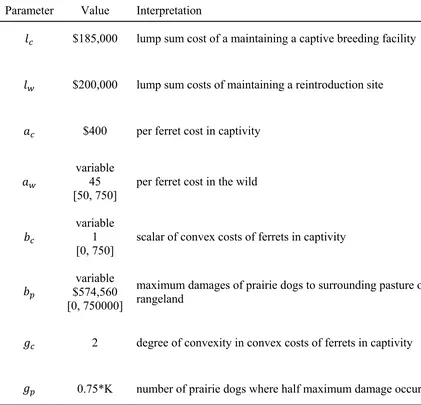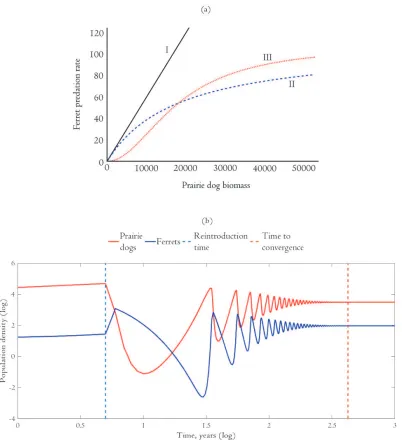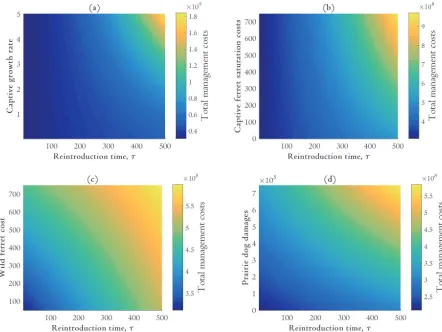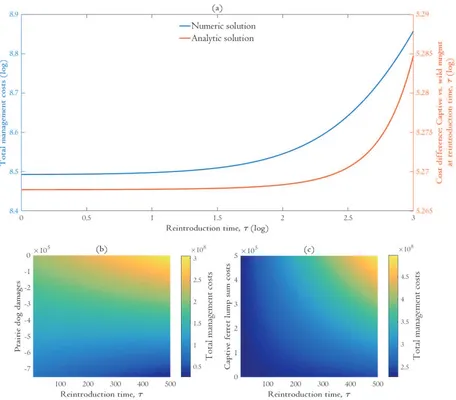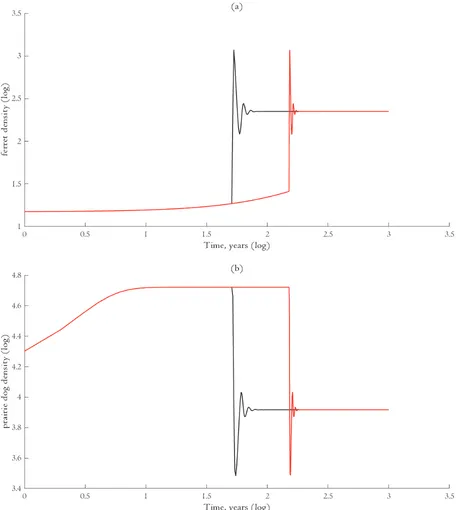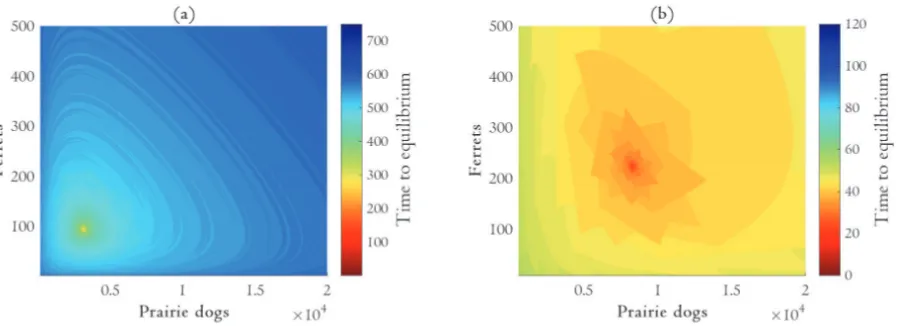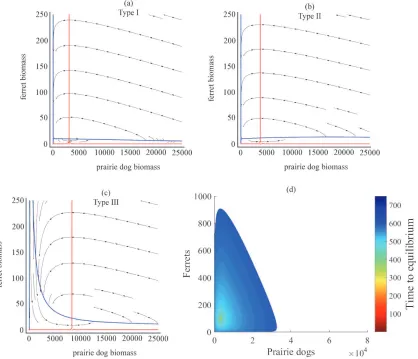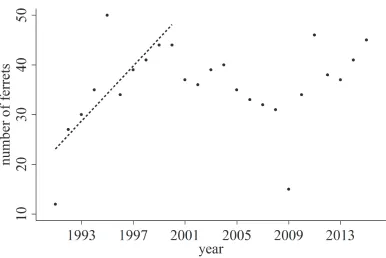1
The optimal timing of reintroducing captive populations into the wild
Richard T Melstrom2,b melstrom@okstate.edu Kehinde Rilwan Salau3,c krsalau@math.arizona.edu David W Shanafelt1,4,a,d dshanafe@asu.edu
1
Centre for Biodiversity Theory and Modelling. Theoretical and Experimental Ecology Station. 2
Department of Agricultural Economics, Oklahoma State University 3
Department of Mathematics, University of Arizona 4
School of Life Sciences, Arizona State University a
Arizona State University, School of Life Sciences, PO Box 874601, Tempe, AZ 85287, USA b
Department of Agricultural Economics, Oklahoma State University, 317 Agricultural Hall, Stillwater, OK 74078, USA
c
Department of Mathematics, The University of Arizona, 617 North Santa Rita Ave, Tucson, AZ 85721, USA
d
2
Abstract
We examine a conservation problem in which the recovery of an endangered species depends on a captive breeding and reintroduction program. The model is applied to the case of the black-footed ferret (Mustela nigripes), an endangered species in North America reliant on captive breeding for survival. The timing of reintroduction is an important concern in these programs as there is a tradeoff between the duration (and therefore the cost) of the captive breeding program and the period the population spends in recovery and in the wild. In this paper, we develop a stylized bioeconomic model to determine the optimal reintroduction time, in which the objective is to minimize the cost of reintroduction while providing a viably-sized population in the wild. Our control variable is the timing of reintroduction, which departs from a large body of work in bioeconomics that focuses on adjustable controls that directly affect the target population. Generally, we find it is optimal to reintroduce ferrets early in a reintroduction program, although this result is contingent on species interactions and provisioning services.
Keywords
3
1. Introduction
Wildlife translocation and reintroduction is a popular but costly conservation tool. Over the last few decades, several hundred reintroduction programs have augmented existing or reestablished extirpated wildlife populations (Wolf et al. 1996). However, these programs are frequently criticized as expensive and ineffective (Ricciardi and Simberloff 2009; Kleiman, Stanley, and Beck 1994). Translocation typically follows a period of captive breeding, which requires substantial investments in facilities, fodder and genetic diversity maintenance, and many reintroductions fail to establish a sustainable population (Wolf et al. 1996).
One of the flagship species for reintroduction in North America is the black-footed ferret (Mustela nigripes). Originally prevalent across the Great Plains, mountain basins, and semi-arid grasslands of North America, the black-footed ferret became one of the most endangered species as a result of the sharp decline in its primary food source, prairie dogs, due to habitat conversion, disease, and poisoning (Miller, Reading, and Forrest 1996). In fact, between 1979 and 1981, the black-footed ferret was presumed extinct (USFWS 2013). In 1981, a remnant population was discovered in Meeteetse, Wyoming but after a series of disease outbreaks in the early 1980s all surviving ferrets were removed from the wild and placed in captive breeding programs. The ferret recovery strategy must combine captive breeding and reintroduction to achieve a population level that no longer warrants a listing of threatened or endangered under the U.S. Endangered Species Act (ESA). Reintroduction programs were initiated post-1990, with mixed success. Currently it is estimated that there is a minimum of 418 adult, breeding individuals among 11 reintroduction sites, with another 280 individuals in captivity (USFWS 2013).
This paper analyzes the optimal timing of translocation while accounting for the costs of managing captive and wild populations. We develop a bioeconomic model of captive rearing and reintroduction, including a wild prey population for the reintroduced individuals. We then use this model to determine the reintroduction time that minimizes total management costs, which include post-reintroduction costs associated with disease management, among other economic values. If the management objective is to minimize the costs of reintroduction subject to providing a viable long-term population in the wild, then a manager must consider the direct financial costs of managing the species in question, plus any indirect costs and benefits generated by the reintroduced species.
Existing studies of reintroduction programs tend to focus on post-reintroduction outcomes.1 Population viability analyses are commonly used to account for stochastic events and identify minimum viable populations for endangered species (Beissinger and Westphal 1998). However, these analyses abstract from economic considerations. For black-footed ferrets, research has also focused on the influence of age structure (Klebanoff et al. 1991), habitat heterogeneity and space (Bevers et al. 1997), and uncertainty (Seal et al. 1989) in preparing for reintroductions. Thus, there is a critical need for research that incorporates economics into reintroduction problems.
Bioeconomic models that integrate economic and biophysical components are often used to show that failure to consider relevant costs and benefits in resource conservation leads to inefficient outcomes (Clark 1973; Clark and Munro 1976; Clark and Kirkwood 1986; Wilen and Brown 1986; Mesterton-Gibbons 1987, 1988; Crocker and Tschirhart 1992; Brock and
1
4
Xepapadeus 2002). Among other topics, these models have been used to analyze fisheries (Gordon 1954; Hilborn 1976; Sanchirico and Wilen 1999), biological invasions (Leung et al. 2002; Horan and Fenichel 2007; Fenichel, Horan, and Hickling 2010; Epanchin-Niell and Hastings 2010; Homans and Horie 2011), and endangered species (Alexander 2000; Melstrom and Horan 2014). Several bioeconomic papers on the subject of endangered species examine reintroduction problems. Rondeau (2001) was among the first to examine the management of a reintroduced population with a bioeconomic model, while Horan and Melstrom (2011) include the possibility of reintroducing captive animals if the wild population goes extinct. Canessa et al. (2015) examine the issue of reintroduction under uncertainty.
This paper contributes to bioeconomic research by explicitly examining the timing of translocation for captive breeding and reintroduction programs. We build on prior work by using optimal control theory to determine the solution to an optimization problem in which time, rather than a stock or harvest variable, is the control. Very few studies consider time as the control (though see Amit (1986)). Although conceptually similar, the classic Faustmann rotation problem and its extensions consider a single period of net benefits in the optimization process (Conrad 1999; Newman, Gilbert, and Hyde 1985; Loisel 2011; Olschewski and Benitez 2010; van Kooten, Binkley, and Delcourt 1995). This is in contrast with our problem, in which
benefits or costs are accrued before and after reintroduction. Researchers may therefore find the methods in this paper useful in solving other endogenous time problems. The solution to black-footed ferret application implies that translocation and reintroduction should either take place immediately or be delayed indefinitely, depending on economic values and the biology of the captive population. We confirm this solution using brute-force numerical optimization.
2. Background
Black-footed ferrets are one of the most endangered species in the world. The species, a type of mustelid native to the prairies and mountain grasslands of North America, is famous for its 20th century decline and eventual status as extinct-in-the-wild.
Originally listed as endangered in 1967 (Udall 1967) and 1970 (Russell 1970), the black-footed ferret was grandfathered into the Endangered Species Act of 1973. Its historical range comprised approximately 100 million acres (40.5 million hectares) of intermountain and prairie grasslands stretching from Canada to Mexico wherever prairie dogs occurred (Hillman and Clark 1980; Anderson et al. 1986). Estimates of historic ferret populations range between half a
million to one million individuals (Anderson et al. 1986). However, starting at the end of the nineteenth century, the ferret population was gradually devastated by declines in prairie dogs due to habitat conversion, poisoning, and disease (USFWS 2013). By 1964 ferrets were classified as "extremely rare" (Henderson, Springer, and Adrian 1969) and presumed extinct in 1979
5
Since 1991 there have been 20 black-footed ferret reintroduction projects, which have had mixed success (USFWS 2013). As of 2011, the U.S. Fish and Wildlife Service program had produced more than 7,000 ferrets in captivity, of which more than 2,600 had been translocated to the wild. Currently, population estimates suggest there are less than 500 breeding adult ferrets in the wild, although the number of known, documented wild ferrets is much less (USFWS 2013). The scale of difference between the number of produced ferrets and the size of the existing wild population suggests there may be inefficiencies in the reintroduction program.
To delist black-footed ferrets as an endangered species, the following criteria must be met for a period of at least three years (USFWS 2013):
Maintain a captive breeding population of at least 280 individuals (at least 105 males and 107 females) across at least three captive breeding facilities
Establish a free-range population of at least 3,000 breeding individuals distributed across no less than 30 populations (at least one population in 9 of the 12 states within the historical range)
Each population must have no fewer than 30 breeding individuals (at least 10 populations must have 100+ breeding individuals); at least five populations must contain Gunnison's and white-tailed prairie dog colonies
Maintain approximately 200,000 hectares of occupied prairie dog habitat at black-footed ferret reintroduction sites, including plans for plague management and prairie dog conservation
To meet these criteria, managers must establish several dozen black-footed ferret reintroduction sites with viable populations, which requires knowledge about the dynamics of ferrets and prairie dogs. Managers must be cognizant of the stock of prairie dogs prior to translocation as well as the potential ferret carrying capacity. If the number of ferrets exceeds what can be supported by the stock of prairie dogs, the prey will be overexploited and the ferret population will crash.
Implicitly, the delisting criteria must be satisfied without exceeding the funding allocated to the national reintroduction project. This means that managers are pursuing both ecological and economic goals. Costs are incurred in raising ferrets in captivity and managing prairie dogs in the wild (pre-introduction), and managing both prairie dogs and ferrets in the wild (post-introduction). Managers need to identify a reintroduction strategy that establishes viable populations in a least-cost manner.
3. Ecology
This section presents a basic, idealized population model of black-footed ferrets and prairie dogs. Black-footed ferrets are obligate predators, with prairie dogs comprising over 90% of their diet (Sheets, Linder, and Dahlgren 1972; Campbell et al. 1987). The ferrets' historic range coincides with three species of prairie dog (white-tailed, black-tailed, and Gunnison's), though no study indicates a preference for any species. Ferrets also use prairie dog burrows for shelter (Biggins 2006; Hillman 1968). Much is known about the demography of ferrets and prairie dogs
6
1982; Reading 1993) but relatively little work has modeled these two species jointly as a predator-prey system (though see Bevers et al. (1997) and Klebanoff et al. (1991)).
Consider a potential black-footed ferret reintroduction site, e.g. a single patch that can support black-footed ferrets and prairie dogs. We denote these two populations as p and f for prairie dogs and ferrets, respectively. This predator-prey system is defined by the following system of equations: ferret (the functional response), is the conversion efficiency of prairie dog to ferret biomass, and m f t
is mortality of ferrets at time t. Several studies show that prairie dogs exhibit logistic growth (Miller, Reading, and Forrest 1996; Reading 1993; Garrett, Hoogland, and Franklin 1982; Knowles 1982). This implies that g p t
r
1p t
/K
where the prairie dog intrinsic growth rate and carrying capacity are given by r and K, respectively. Bevers et al. (1997) suggest that ferrets also experience logistic growth, though other studies attribute this phenomena to a functional response to prey populations rather than logistic growth in thepredator species (Klebanoff et al. 1991). The exact nature of the functional response of ferrets to prairie dogs is unclear. In the application, we consider three different predator response
functions (Holling 1959).2
Modeling ferret-prairie dog interactions as the system of equations [1]-[2] requires several assumptions about ferret-prairie dog dynamics. First, no dispersal occurs for either species. Both ferrets and prairie dogs are territorial species, and young often disperse from their natal colonies (Miller, Reading, and Forrest 1996; USFWS 2013; Hoogland 2013; Garrett and Franklin 1988). By considering a single, representative reintroduction site we assume there is sufficient "space" for individuals to disperse and form new colonies within the boundaries of the site. With few exceptions, ferret reintroduction sites are spatially distinct such that no natural dispersal occurs between them (USFWS 2013). Second, we aggregate all age and sex classes into a single compartment for each species. This assumption is common in the ferret modeling literature (though see Klebanoff et al. (1991) for an example of an age-structured model). Third, the speed of dynamics is the same for ferrets and prairie dogs. Finally, we do not explicitly model dynamics associated with disease or higher-level trophic predators; these issues are dealt with implicitly through existing parameters (e.g. ferret mortality rate).
2
7
4. Bioeconomics
The recovery and delisting objectives faced by managers require growing and translocating captive populations to the wild at minimal cost. This implies the following cost minimization problem:
where managers choose the time, , to reintroduce a captive population of ferrets to the wild. The stock of ferrets in captivity is denoted by fc, ferrets in the wild by fw. The stocks of prairie dogs in the wild pre- and post- reintroduction are given by pc and pw respectively.
The planning horizon ends at time T, an exogenous parameter. Other bioeconomic models of wildlife conservation similarly assume that management occurs within a fixed interval (Haight 1995; Spring et al. 2001; Nalle et al. 2004). Management of imperiled species is often viewed as temporary, lasting until it is clear extinction risks will not occur. Consequently, endangered species recovery and habitat conservation plans typically have expected end dates (Suckling 2006; Bernazzani, Bradley, and Opperman 2012).3 We assume that by time T in situ management is no longer required in the wild because problems with habitat and disease, which are beyond the scope of our model, will have been solved.
The scrap “cost” () is associated with costs outside of direct management after the end of the conservation plan (e.g. additional monitoring and indirect costs such as prairie dog
damages to farmland). The discount rate is given by δ.
In addition, we evaluate the minimum and maximum numbers of ferrets and prairie dogs that may be present at the point of introduction ( fmin fc
fmax and pmin pc
pmax) as biological criteria for reintroduction. They are the combinations of ferrets and prairie dogs (initial conditions) that result in a positive, long-run coexistence of the two species. These criteria are not considered explicitly in the optimization of [3], but are instead evaluated ex poste as a check for suitable biological conditions necessary for reintroduction. We further assume3
8
that during the pre-introduction stage no ferrets are present in the reintroduction site ( fw 0 if t) and that all captive ferrets are released into the wild at time ( fc 0 if t).
There are several different cost functions. Viable ferret habitat must be populated with sufficient prairie dogs, which requires prairie dog monitoring, vaccinations and other general site management costs (USFWS 2013). Prairie dogs are sometimes thought of as pests, disturbing grazing sites for cattle. Furthermore, ferrets must be bred in captivity, which incurs food and maintenance costs, vaccinations, and training (USFWS 2013; Biggins et al. 1999). Ferret costs in captivity are captured by cc
f tc
, with concurrent prairie dog monitoring costs of
p c
c p t appearing in the first term of [3]. After introduction, managers continue to expend resources associated with monitoring prairie dogs as well as wild ferrets (USFWS 2013; Holmes 2008). Prairie dogs must be monitored before and after ferret reintroduction, and because they are often viewed as a nuisance to productive rangelands, black-footed ferrets provide regulating ecosystem services through prairie dog control. These costs are found in the second term of [3] (cp
pw
t
and cw
fw
t
respectively). The cost function for prairie dogs can also be viewed as a damage function for variable rangeland.In order to solve for the optimal reintroduction time, we adopt a first-principles approach following Conrad and Clark (1987) and Clark (2010). In optimal control theory, we often take the necessary first order condition(s), and adjoint and transversality equations as given. In fact they are derived by equating the change in the Lagrangian for a small change in the control to zero. We write the current-value Lagrangian describing the total costs of managing ferrets and prairie dogs in perpetuity as:
[4] L f
c,fw,p pc, w, , T
pre- and post- introduction respectively.We use [4] together with the biological constraints in [3] to define the necessary conditions to solve for the optimal reintroduction time, *. Derivations of similar problems exists in Amit (1986), Kamien and Schwartz (1991), Dixit and Pindyck (1994), and Lenhart and Workman (2007).
9
That is, the change in the Lagrangian over the entire time horizon is equal to zero. Equation [5] forms the basis for deriving the traditional necessary first order conditions, adjoint equations, and transversality conditions in resource economics (Clark 2010; Conrad and Clark 1987).
The first term on the right-hand side of [5] is the direct change in the Lagrangian for a small change in the reintroduction time. This forms the necessary first order condition for cost minimization. The bracketed terms reflect the secondary effects that a small change in the reintroduction time has on the Lagrangian. Changes to the reintroduction time - an input to the biological model - will perturb ferret and prairie dog abundances and by extension, the
Lagrangian. From [5] we can derive the following conditions that must hold for an optimal (see Supplemental Material A for details):
[6] cc
fc
cw
fw
Condition [6] forms the necessary first order condition for optimality. It says that at the time of reintroduction, *, the costs of managing ferrets in captivity must equal the costs of managing ferrets in the wild.4 In other words, managers should only consider translocating ferrets from captivity into the wild when they are financially indifferent between continuing to
4
As in other studies of interacting species (Mesterton-Gibbons, 1988; Wilen and Brown, 1986), intuitively we would expect condition [6] to include prairie dogs. Prairie dogs drop out of the solution by the nature of the cost functions and the general setup of the problem. We would expect the cost functions of managing prairie dogs to be the same pre- and post-reintroduction. Since we choose the reintroduction time such that the change in the
10
nurture ferrets in a controlled environment and monitoring free roaming ferrets. This is a necessary but not a sufficient condition to determine exact time of reintroduction.5
It is interesting to compare condition [6] with the solution to analogous resource problems; namely, timber management. For a stand of timber, the optimal single rotation requires solving for the length of time t where the marginal value of allowing the stand to grow equals the marginal cost of waiting to cut (Conrad 1999). Here, the marginal value of allowing the ferrets to grow in captivity is the cost savings of delaying reintroduction and spending on wild ferret management, and the marginal cost of delaying reintroduction is the spending
required to support the captive breeding program. However, an important difference between our problem and a rotation problem is that ferret management suffers costs before and after
reintroduction, and timber management collects benefits only at the time the stand is felled. Conditions [7] and [8] describe the trajectory of the shadow values of ferret and prairie dogs post-reintroduction (adjoint equations). These shadow values measure the costs of an additional animal on managing ferrets and prairie dogs into the future. Conditions [9]-[12] form initial and terminal time (transversality) conditions for the shadow values in the
post-reintroduction period of the problem. There are no adjoint equations from the pre-introduction part of the problem because the first part in the right hand side of [4] is, in essence, not
controlled by management until the point of reintroduction. The solution only uses information about the system when a control is applied to the system - in our case, when ferrets are
reintroduced into the wild (Clark 2010; Conrad 1999; Conrad and Clark 1987; Lenhart and Workman 2007).
It is worth reiterating that an optimal candidate reintroduction time must satisfy the full suite of conditions in equations [6]-[12] - the necessary first order condition alone is not
sufficient. However, the system of equations in [6]-[12] generally precludes the possibility of an interior, analytical closed-form solution. The system is over-determined because an optimal * must satisfy the necessary first order conditions and both initial and terminal boundary
conditions - a unique solution that is difficult to satisfy for general suites of parameters (Cronin 2007). In order to overcome this, we develop a numerical method that explicitly accounts for the
5
If we do not want to require that ∗ lies strictly between the initial time and final time, then a more complete set of necessary conditions include:
11
population dynamics of ferrets and prairie dogs and the changing costs associated with altering the reintroduction time. This is discussed in the next section.
5. Application
5.1. Biology
We now specify functional forms for the ferret-prairie dog system. A detailed understanding of the biological system allows us to characterize the conditions required for coexistence and map the quantities of each species required to establish a long-term population. First, we assume that ferrets in captivity grow at a constant growth rate. Second, as discussed in the ecology section, growth of prairie dogs is modeled as a logistic function. For simplicity, the mortality of ferrets is assumed to occur at a fixed rate, so that m f t
df t
. The choice of functional response is nontrivial, so we examine three functional forms commonly used in the ecology literature. We first characterize the functional response as a type I response – where the predation rate remains constant regardless of the number of prey (prairie dogs) and predators (ferrets). This implies[1*] dp rp t
1 p t
p t f t
where is a measure of predation efficiency. By contrast, a type II predator response transforms equations [1*] and [2*] into:
[1**]
where ferret predation efficiency is generalized to account for ferret maximum feeding rate, , and a feeding half-saturation constant, D.6 A type II response function yields a positive, nonlinear relationship between the quantity of prey consumed per predator and the quantity of prey present. A type III predator response function is given by:
[1***]
12
This produces a sigmoid relationship between predation rate and prey. Figure 1a provides a visual representation of each predator response function. For robustness, we initially consider each response function as a potentially valid characterization of the relationship between ferrets and prairie dogs.
We parameterized the system using values reported in the literature (Table 1). For each system of equations, we identified and conducted a stability analysis of all the steady-state solutions (Table 2). We then numerically simulated each system of equations under a suite of initial conditions to evaluate the (pre-introduction) combinations of prairie dogs and ferrets that generate viable populations. We also measured the time it took for each population to reach percent from their equilibrium values. For our simulations we used an extinction threshold of 0.1 to reflect a critical threshold under which a population would not be able to recover (e.g. demographic stochasticity or Allee effects). This methodology allowed us to find the quantities of prairie dogs (pre-introduction) and introduced ferrets that yield a long-term population as well as describe the nature of the resulting steady-state equilibrium. Stability analyses were
conducted in Mathematica 9.0 (Wolfram, 2015). Numerical simulations were conducted using a third order Runge-Kutta with an adaptive step size in MatLab (MatLab, 2015).
Numerical simulations implied that the type I and type II response functions are biologically intractable. For brevity, the details on these simulations are contained in
Supplementary Material C. We found that it was impossible for the two species to coexist with the type II response function. The system also frequently crashed with the type I response function if there were initially too many prairie dogs, which we considered implausible. For this reason the remainder of the analysis focuses on the results from the model that uses the type III response function.
Our simulations suggest a large parameter space of initial conditions in which ferrets and prairie dogs coexist given a type III response function. The number of ferrets raised in captive breeding facilities typically falls within this range. (See, for example, Figure S4 in Supplemental Material D.) This suggests that the ex poste biological constraints of [3] will be satisfied for empirical applications.
5.2. Economics
In order to solve for the optimal time to reintroduction, *, we must specify cost functions for all terms in [3]. We define the costs of captive ferrets as:
[13]
gcc c c c c c c
c f t l a f t b f t
The first term, lc, is the lump sum cost of maintaining a captive breeding facility. The second term, ac, represents costs that vary linearly with the number of ferrets, e.g. food, vaccines, and training or acclimation to wild conditions. The final terms, bc and gc, are the convex costs associated with achieving a constant ferret growth rate while increasing the captive population. As the captive population grows in size, it becomes increasingly difficult for managers to expand the breeding facility and maintain a fixed growth rate, implying the costs associated with
13
After ferrets are reintroduced into the wild, there are management costs, aw, associated with each ferret, namely vaccination:
[14] cw
fw
t
a fw w
tFor managing wild prairie dogs, costs come in two forms. First, there are costs associated with maintaining a reintroduction site. This includes rental and maintenance of facilities, salaries and wages, vehicles, and equipment. Vaccinations and treatment for disease are often granted as single multi-year allocations and are considered part of our lump sum cost. Second, private economic costs can arise from the damages prairie dogs inflict upon the
rangeland and decrease its productivity for livestock (Reading 1993; USFWS 2013). The costs of prairie dogs are therefore:
[15]
where lw is the lump sum cost of a reintroduction site and bp are the maximum damages prairie dogs impose on potential ranchland. Indirect costs saturate according to the parameter gp, which is the number of prairie dogs at which 50% of ranchland productivity is lost.
Cost functions and their parameter values were calibrated from the Phoenix Zoo's black footed ferret captive breeding facility (pers. comm.) and the Aubrey Valley black-footed ferret reintroduction site (pers. comm.). We present the full list of parameter values in Table 3.
5.3. Characterizing the analytic solution
While it is difficult to satisfy the full suite of conditions for optimality in [6]-[12] (Cronin 2007), analyzing the necessary first order condition can provide intuition into the features that define an optimal reintroduction time. Beginning with condition [6] we highlight which combinations of parameter values may allow for an interior solution. However, when substituting realistic parameter values we find that the number of ferrets to be released at the optimal reintroduction time is a complex root. This implies that our solution for the optimal reintroduction time (*) is a corner.
Recall that in the analytic solution the necessary condition for the existence of an interior optimal reintroduction time, *, requires that the ferret management costs in captivity equal the ferret management costs in the wild, i.e.
*
*
c c w w
c f c f . Substituting the economic functions specified in equations [13]-[14], we derive the reintroduction time for a given set of parameters (Supplemental Material B). That is, at time *
14 where *
c
f is the size of the captive ferret population ( fc) at the optimal reintroduction time (*). The solution is restricted to real, positive values. Assuming that the captive growth process is approximated with a linear term a (dfc
a
dt ), then a solution for the growth dynamics of captive ferrets is f tc
at fc0 where fc0 fc
0 is the initial number of captive ferrets. Then theEquations [16] and [17] imply that early reintroduction times and small translocated populations occur when the costs associated with captive breeding are high. Indeed, a necessary condition for the positivity of *
c
f is that the marginal cost of the first wild ferret management exceeds the marginal cost term of the first captive-bred ferret (i.e. aw ac). If this condition does not hold, then the optimal solution is to reintroduce captive ferrets immediately - per ferret, it is cheaper to let ferrets grow in the wild than in captivity (naturally, this assumes that the extinction threat has been addressed). We find that the lump sum cost of captive ferret management (lc) and the quadratic coefficient for convex ferret management costs in the wild (bc) are negatively correlated with *
c
f and *. The more expensive it is to raise ferrets in captivity, the sooner the optimal release time and population size. Substituting realistic parameter values into equations [16] and [17] yields a complex root, suggesting that the optimal reintroduction time is a corner solution. This result is confirmed by numerical analysis below (Figures 2 and 3).
5.4. Numerical analysis
In order to evaluate the intuition gained from analyzing the necessary first order condition and overcome some of the limitations of the analytic solution, we construct a numerical scheme to calculate the optimal reintroduction time using brute-force, simulation methods. The numerical scheme allows us to provide an accurate solution under different modeling scenarios.
For a given set of initial conditions (captive ferrets and wild prairie dogs) and candidate reintroduction times, the numerical scheme:
1. Solves the population equations up to the candidate reintroduction time
Calculates management costs from the initial time until the reintroduction time Stores terminal values of captive ferret and wild prairie dogs
2. Solves the populations equations from the reintroduction time to the terminal time Calculates the management costs over this cost horizon
15
is the candidate reintroduction time definitively interior (Figure 3b). These results are in agreement with our analytic analysis above.
Holding other economic parameters constant, it seems that the reintroduction time is relatively insensitive to changes in captive ferret growth rates. Additional costs associated with breeding ferrets at a faster rate in captivity are outweighed by the damages caused by prairie dogs in the wild.
Figures 2 and 3 also illustrate intervals of candidate reintroduction times in which
managers can reintroduce ferrets and not incur significant costs. This result implies the existence of reintroduction thresholds which, if crossed (e.g. ferrets are reintroduced too late) lead to cost penalties. For instance, when captive growth rates vary between 0 and 5 the cost of the total management program changes insignificantly if managers reintroduce ferrets within 50 years (Figure 2a). But waiting until 100 years results in substantially larger costs.
6. Discussion
Our analyses indicate that reintroduction should occur as soon as possible, i.e. a corner solution (Figures 2, 3). While we initially derived a general set of analytic conditions for an optimal reintroduction time, our results suggest an interior solution cannot be optimal. This important result implies that there are only two courses of action to protect ferrets: reintroduce
immediately or maintain the captive population indefinitely. The sensitivity analyses illustrated in Figures 2 and 3 provide robust evidence that reintroduction should begin immediately.
To this end, our results indicate that we should direct our conservation efforts to address in situ problems for reintroduction, namely threats to ferret survival in the wild. Ferrets are sensitive animals and their populations experience sharp responses to changes in their prey base, environmental conditions, and disease (USFWS 2013). Of particular concern are canine
distemper and sylvatic plague, diseases spread through animal-to-animal contact and indirectly via flea vectors or contaminated material (USFWS 2013; Antolin et al. 2002). Current efforts are underway to increase ferret survival including acclimatization, training, and the development of vaccines and practices to manage disease (USFWS 2013; Abbott et al. 2012).
In focusing on the bioeconomics of translocation, this analysis touches on the issue of ex situ management. The major theme in bioeconomics has been the optimal extraction or in situ management of natural resources (Tschirhart 2009; Conrad and Clark 1987; Conrad 1999). In contrast, translocation is an ex situ control that must account for ex ante and ex post population dynamics to determine its success. Models in the existing literature largely assume direct control over the target species, e.g. harvest or stocking.7 Furthermore, traditional solution methods in optimal control theory were developed for resource management problems involving the dynamic allocation of resources, i.e. how investments in in situ resource management should change over time (Clark 1976). Resource problems involving one-off investments do not fit into
7
16
this framework. For this type of resource economics problem, the control variable is effectively a single-use, impulse control.8
Many model extensions are beyond the scope of this paper and are left for future work. We discuss three of them here. First, our model provides an idealized representation of the ferret and prairie dog system in that it is deterministic and does not capture fluctuations in predator or prey populations due to seasonal variability in temperature or rainfall. In reality, small
fluctuations in prairie dog biomass can have large effects on ferret populations and ferrets themselves are sensitive to environmental conditions (USFWS 2013). Second, our models are not spatial. Both species disperse from their natal colonies to form additional territories (USFWS 2013), which has implications for the conservation of each species. Metacommunity theory suggests that species dispersal can replace locally extinct species populations or prevent local extinction by replenishing declining populations (Brown and Kodric-Brown 1977; Shmida and Wilson 1985; Holt 1985; Pulliam 1988). The sensitive nature of ferret populations suggests that a network of spatially-connected populations would increase the resilience of the species to spatial-temporal environmental shocks. Finally, disease is an on-going management problem, with insecticides and vaccines currently being used to protect reintroduced populations. In our model disease dynamics can be implemented in a straightforward way, though it will change the necessary first order conditions for optimization. One approach is to treat disease states as separate species classes or compartments, e.g. the classic Susceptible-Infected-Recovered (SIR) epidemiological model (Lenhart and Workman 2007).
7. Conclusion
Generally we find that it is optimal to reintroduce ferrets early on in the reintroduction program, particularly if the costs of prairie dogs and thus the benefits of ferret ecosystem services are high. Based on the set of parameters examined, it looks as though the optimal duration of the captive breeding program is short relative to current ferret management practices. We attribute part of this difference to on-going habitat threats, rather than purely inefficiencies in the ferret
translocation strategy. However, our results imply that reintroduction should be delayed only until in situ threats to introduction are addressed.
More generally, our research suggests that captive breeding programs with expensive marginal animal costs should be short-lived with the animals quickly reintroduced into the wild. An example of an efficient captive breeding program may be seen in the case of the California Island Fox, whose wild population was effectively extirpated by invasive golden eagles. After the foxes were placed on the U.S. endangered species list in 2004, captive breeding populations were set up. After the eagles were removed, the captive-bred population was quickly
reintroduced to the wild and has since recovered sufficiently to be removed from the endangered species list.
8
17
8. Acknowledgements
We would like to thank the Arizona Fish and Game Department for cost and population census data of Arizona's Aubrey Valley reintroduction site. We would also like to acknowledge the Phoenix Zoo for providing cost and population data for the Phoenix Zoo captive breeding
program; calibration of our models would not have been possible without their support. KRS was supported by the NSF Alliance for Building Faculty Diversity Postdoctoral Fellowship
[NSF 733 grant number DMS-0946431].
9. References
Abbott, R.C., J.E. Osorio, C.M. Bunck, and T.E. Rocke. 2012. "Sylvatic plague vaccine: A new tool for conservation of threatened and endangered species?" EcoHealth no. 9 (3):243-250.
Alexander, R.R. 2000. "Modelling species extinction: The case for non-consumptive values." Ecological Economics no. 35 (2):259-269.
Amit, R. 1986. "Petroleum reservoir exploitation: Switching from primary to secondary recovery." Operations Research no. 34:534-549.
Anderson, E., S.C. Forrest, T.W. Clark, and L. Richardson. 1986. "Paleobiology, biogeography, and systematics of the black-footed ferret, Mustela nigripes (Audubon and Bachman), 19851." In Great Basin Naturalist Memoirs No. 8: The Black-Footed Ferret, edited by S.L. Wood, 11-62. Brigham Young University.
Antolin, M.F., P. Gober, B. Luce, D.E. Biggins, W.E. Van Pelt, D.B. Seery, M.L. Lockhart, and M. Ball. 2002. The influence of sylvatic plague on North American wildlife at the landscape level, with special emphasis on black-footed ferret and prairie dog conservation. Paper read at Transactions of the 67th North American Wildlife and Natural Resources Conference, at Washington, D.C.
Beissinger, S.R., and M.I. Westphal. 1998. "On the use of demographic models of population viability in endangered species management." Journal of Wildlife Management no. 62 (3):821-841.
Bernazzani, P., B.A. Bradley, and J.J. Opperman. 2012. "Integrating climate change into habitat conservation plans under the US Endangered Species Act." Environmental Management no. 49 (6):1103-1114.
Bevers, M., J. Hof, D.W. Uresk, and G.L. Schenbeck. 1997. "Spatial optimization of prairie dog colonies for black-footed ferret recovery." Operations Research no. 45 (4):495-507. Biggins, D.E. 2006. The symposium in context. In Recovery of the Black-Footed Ferret:
Progress and Continuing Challenges, edited by J.E. Roelle, B.J. Miller, J.L. Godbey and D.E. Biggins. Reston, Virginia: U.S. Department of the Interior, U.S. Geological Survey. Biggins, D.E., B.J. Miller, L.R. Hanebury, B. Oakleaf, A.H. Farmer, R. Crete, and A. Dood.
1993. A technique for evaluating black-footed ferret habitat. Paper read at Management of prairie dog complexes for the reintroduction of the black-footed ferret.
18
Brock, W., and A. Xepapadeus. 2002. "Optimal ecosystem management when species compete for limiting resources." Journal of Environmental Economics and Management no. 44:189-220.
Brown, J.H., and A. Kodric-Brown. 1977. "Turnover rates in insular biogeography: Effect of immigration on extinction." Ecology no. 58 (2):445-449.
Campbell, T.M., T.W. Clark, L. Richardson, S. Forrest, and B.R. Houston. 1987. "Food habits of Wyoming black-footed ferrets." American Midland Naturalist no. 117 (1):208-210. Canessa, S., S.J. Converse, M. West, N. Clemann, G. Gillespie, M. McFadden, A.J. Silla, K.M.
Parris, and M.A. McCarthy. 2015. "Planning for ex-situ conservation in the face of uncertainty." Conservation Biology no. Accepted article.
Clark, C.W. 1973. "The economics of overexploitation." Science no. 181 (4100):630-634. ———. 1976. Mathematical bioeconomics: The optimal management of renewable resources.
New York: John Wiley and Sons Inc.
———. 2010. Mathematical bioeconomics: The mathematics of conservation. 3rd ed. Hoboken, New Jersey: John Wiley & Sons, Inc.
Clark, C.W., and G.P. Kirkwood. 1986. "On uncertain renewable resource stocks: Optimal harvest policies and the value of stock surveys." Journal of Environmental Economics and Management no. 13:235-244.
Clark, C.W., and G.R. Munro. 1976. "The economics of fishing and modern capital theory: A simplified approach." Journal of Environmental Economics and Management no. 2:92-106.
Clark, T.W. 1986. "Technical introduction." In Great Basin Naturalist Memoirs No. 8: The Black-Footed Ferret, edited by S.L. Wood, 8-10. Brigham Young University. Conrad, J.M. 1999. Resource economics. New York: Cambridge University Press. Conrad, J.M., and C.W. Clark. 1987. Natural resource economics: Notes and problems:
Cambridge University Press.
Crocker, T.D., and J. Tschirhart. 1992. "Ecosystems, externalities, and economies." Environmental Resource Economics no. 2:551-567.
Cronin, J. 2007. Ordinary differential equations: Introduction and qualitative theory. 3rd ed: Chapman and Hall.
Dasgupta, P., and G. Heal. 1974. "The optimal depletion of exhaustible resources." The Review of Economic Studies no. 41:3-28.
Dixit, A.K., and R.S. Pindyck. 1994. Investment under uncertainty. Princeton, New Jersey: Princeton University Press.
Epanchin-Niell, R.S., and A. Hastings. 2010. "Controlling established invaders: integrating economics and spread dynamics to determine optimal management." Ecology Letters no. 13:528-541.
Fenichel, E.P., R.D. Horan, and G.J. Hickling. 2010. "Bioeconomic management of invasive vector-borne diseases." Biological Invasions no. 12:2877-2893.
Garrett, M.G., and W.L. Franklin. 1988. "Behavioral ecology of dispersal in the black-tailed prairie dog." Journal of Mammalogy no. 69 (2):236-250.
Garrett, M.G., J.L. Hoogland, and W.L. Franklin. 1982. "Demographic differences between an old and a new colony of black-tailed prairie dogs (Cynomys ludovicianus)." American Midland Naturalist no. 108 (1):51-59.
19
Gotelli, N.J. 1995. A Primer of Ecology. Sunderland, MA: Sinauer Associates.
Haight, R.G. 1995. "Comparing extinction risk and economic cost in wildlife conservation planning." Ecological Applications no. 5 (3):767-775.
Hanebury, L.R., and D.E. Biggins. 2006. A history of searches for black-footed ferrets. In Recovery of the Black-Footed Ferret: Progress and Continuing Challenges, edited by J.E. Roelle, B.J. Miller, J.L. Godbey and D.E. Biggins. Reston, Virginia: U.S.
Department of the Interior, U.S. Geological Survey.
Hartwick, J.M. 1977. "Intergenerational equity and the investing rents from exhaustible resources." The American Economic Review no. 67 (5):972-974.
Henderson, F.R., P.F. Springer, and R. Adrian. 1969. The black-footed ferret in South Dakota. edited by Fish and Parks South Dakota Department of Game. Pierre, South Dakota: U.S. Department of Game, Fish, and Parks.
Hilborn, R. 1976. "Optimal exploitation of multiple stocks by a common fishery: A new methodology." Journal of the Fisheries Research Board of Canada no. 33 (1):1-5. Hillman, C.N. 1968. "Field observations of black-footed ferrets in South Dakota." Transactions
of the North American Wildlife Conference no. 33:433-443.
Hillman, C.N., and T.W. Clark. 1980. "Mustela nigripes." In Mammalian Species No. 126. The American Society of Mammalogists.
Holling, C.S. 1959. "Some characteristics of simple types of predation and parasitism." The Canadian Entomologist no. 91 (7):385-398.
Holmes, B.E. 2008. A review of black-footed ferret reintroduction in northwest Colorado, 2001-2006. In Technical Note 426, edited by Bureau of Land Management U.S. Department of the Interior. White River Field Office, Colorado.
Holt, R.D. 1985. "Population dynamics in two-patch environments: Some anomalous consequences of an optimal habitat distribution." Theoretical Population Biology no. 28:181-208.
Homans, F., and T. Horie. 2011. "Optimal detection strategies for an established invasive pest." Ecological Economics no. 70:1129-1138.
Hoogland, J.L. 2013. "Prairie dogs disperse when all close kin have disappeared." Science no. 339:1205-1207.
Hoogland, J.L., D.K. Angell, J.G. Daley, and M.C. Radcliffe. 1987. Demography and population dynamics of prairie dogs. Paper read at Eighty Great Plains Wildlife Damage Control Workshop, at Rapid City, South Dakota.
Horan, R., and E.P. Fenichel. 2007. "Economics and ecology of managing emerging infectious animal diseases." American Journal of Agricultural Economics no. 89 (5):1232-1238. Horan, R.D., and R.T. Melstrom. 2011. "No sympathy for the devil." Journal of Environmental
Economics and Management no. 62 (3):367-385.
Hotelling, H. 1931. "The economics of exhaustible resources." The Journal of Political Economy no. 39 (2):137-175.
Kamien, M.I., and N.L. Schwartz. 1991. Dynamic optimization: The calculus of variations and optimal control in economics and management. New York: Elsevier Science Publishing Co.
20
Kleiman, M.R., M.R. Stanley, and B.B. Beck. 1994. "Criteria for introductions." In Creative Conservation: Interactive Management of Wild and Captive Animals, edited by P.J.S. Olney, G.M. Mace and A.T.C. Feistner, 287-303. London: Chapman and Hall.
Knowles, C.J. 1982. Habitat affinity, populations, and control of black-tailed prairie dogs on the Charles M. Russel national wildlife refuge, Zoology, University of Montana.
Lenhart, S., and J.T. Workman. 2007. Optimal Control Applied to Biological Models: Chapman and Hall.
Leung, B., D.M. Lodge, D. Finnoff, J.F. Shogren, M.A. Lewis, and G. Lamberti. 2002. "An ounce of prevention or a pound of cure: Bioeconomic risk analysis of invasive species." Proceedings: Biological Sciences no. 269 (1508):2407-2413.
Loisel, P. 2011. "Faustmann rotation and population dynamics in the presence of a risk of destructive events." Journal of Forest Economics no. 17:235-247.
Melstrom, R.T., and R.D. Horan. 2014. "Interspecies management and land use strategies to protect endangered species." Environmental and Resource Economics no. 58 (2):199-218.
Mesterton-Gibbons, M. 1987. "On the optimal policy for combined harvesting of independent species." Natural Resource Modeling no. 2:109-134.
———. 1988. "On the optimal policy for combining harvesting of predator and prey." Natural Resource Modeling no. 3:63-90.
Miller, B., R.P. Reading, and S. Forrest. 1996. Prairie night: Black-footed ferrets and the recovery of endangered species. Washington, D.C.: Smithsonian Institution Press. Nalle, D.J., C.A. Montgomery, J.L. Arthur, S. Polasky, and N.H. Schumaker. 2004. "Modeling
joint production of wildlife and timber." Journal of Environmental Economics and Management no. 48 (3):997-1017.
Newman, D.H., C.B. Gilbert, and W.F. Hyde. 1985. "The optimal forest rotation with evolving prices." Land Economics no. 61 (4):347-353.
Olschewski, R., and P.C. Benitez. 2010. "Optimizing joint production of timber and carbon sequestration of afforestation projects." Journal of Forest Economics no. 16:1-10. Pulliam, H.R. 1988. "Sources, sinks, and population regulation." The American Naturalist no.
132 (5):652-661.
Reading, R.P. 1993. Toward an endangered species reintroduction paradigm: A case study of the black-footed ferret, Yale University.
Ricciardi, A., and D. Simberloff. 2009. "Assisted colonization is not a viable conservation strategy." Trends in Ecology and Evolution no. 24 (5):248-253.
Rondeau, D. 2001. "Along the way back from the brink." Journal of Environmental Economics and Management no. 42:156-182.
Russell, F.J. 1970. "Conservation of endangered species and other fish or wildlife." Federal Register no. 35 (106):8491-8498.
Sanchirico, J.N., and J. Wilen. 1999. "Bioeconomics of spatial exploitation in a patchy
environment." Journal of Environmental Economics and Management no. 37:129-150. Seal, U.S., E.T. Thorne, M.A. Bogan, and S.H. (Eds.) Anderson. 1989. Conservation biology and
the black-footed ferret. New Haven: Yale University Press.
Sheets, R.G., R.L. Linder, and R.B. Dahlgren. 1972. "Food habits of two litters of black-footed ferrets in South Dakota." American Midland Naturalist no. 87 (1):249-251.
21
Solow, R.M. 1974. "Intergenerational equity and exhaustible resources." The Review of Economic Studies no. 41:29-45.
Spring, D.A., M. Bevers, J.O. Kennedy, and D. Harley. 2001. "Economics of a nest-box program for the conservation of an endangered species: A reappraisal." Canadian Journal of Forest Research no. 31 (11):1992-2003.
Suckling, K. 2006. Measuring the success of the Endangered Species Act: Recovery trends in the Northeastern United States: Center for Biological Diversity.
Tschirhart, J. 2009. "Integrated ecological-economic models." Annual Review of Resource Economics no. 1 (1):381-407.
Udall, S.L. 1967. "Native fish and wildlife: Endangered species." Federal Register no. 32 (48):6.
USDA. 2011. Farms, land in farms, and livestock operations 2010 summary (February 2011). edited by USDA National Agricultural Statistics Office.
———. 2015. Land values 2015 summary (August 2015). edited by USDA National Agricultural Statistics Service.
USFWS. 2013. Recovery plan for the black-footed ferret (Mustela nigripes). edited by U.S. Fish and Wildlife Service. Denver, Colorado.
van Kooten, G.C., C.S. Binkley, and G. Delcourt. 1995. "Effect of carbon taxes and subsides on optimal forest rotation age and supply of carbon services." American Journal of
Agricultural Economics no. 77 (2):365-374.
Wilen, J., and G. Brown. 1986. "Optimal recovery paths for perturbations of trophic level bioeconomic systems." Journal of Environmental Economics and Management no. 13:225-234.
Wilson, D.E., and S. Ruff. 1999. The Smithsonian book of North American mammals. Washington, D.C.: Smithsonian Institution Press.
22 Table 1. Summary of biological parameters.
Parameter Value Interpretation Units Reference
a 0.0725 captive ferret growth rate time-1 Phoenix Zoo captive ferret breeding program (Supplementary Material D)
r 0.6 prairie dog reproduction rate time-1 Hoogland et al. (1987); Klebanoff et al. (1991) K 52650 prairie dog carrying capacity p biomass Holmes (2008)
α 0.006 ferret feeding efficiency
f biomass ∗ time Biggins et al. (1993)
β 0.032 prairie dog to ferret biomass conversion efficiency
f biomass
p biomass Biggins et al. (1993); Wilson and Ruff (1999)
d 0.6 ferret mortality rate time-1 Klebanoff et al. (1991) h 0.0092 ferret handling time f biomass ∗ time
p biomass Biggins et al. (1993)
κ 1/h ferret maximum feeding rate p biomass
f biomass ∗ time -
D 1/αh feeding half-saturation constant p biomass -
23
Table 2. Biological steady states and stability of equilibria.
Equilibria Restrictions Eigenvalues Stability of Equilibria
Type I
∗ , ∗ - -0.6, 0.6 Saddle
∗ , ∗ - 9.544, -0.6 Saddle
∗
∗ ∗
∗ -0.0177 + 0.582i
-0.1777 + 0.582i Stable spiral
Type II
∗ , ∗ - -0.6, 0.6 Saddle
∗ , ∗ - 2.002, -0.6 Saddle
∗
∗ ∗ ∗ ∗
0.0263 + 0.526i
0.0263 - 0.526i Unstable spiral
Type III
∗ , ∗ - -0.6, 0.6 Saddle
∗ , ∗ - 2.528, -0.6 Saddle
∗ √
∗ ∗ ∗
∗
∗ -0.213 + 0.676i -0.213 - 0.676i Stable spiral
24 Table 3. Summary of cost parameters.
Parameter Value Interpretation
$185,000 lump sum cost of a maintaining a captive breeding facility
$200,000 lump sum costs of maintaining a reintroduction site
$400 per ferret cost in captivity
variable 45 [50, 750]
per ferret cost in the wild
variable 1 [0, 750]
scalar of convex costs of ferrets in captivity
variable $574,560 [0, 750000]
maximum damages of prairie dogs to surrounding pasture or rangeland
2 degree of convexity in convex costs of ferrets in captivity
0.75*K number of prairie dogs where half maximum damage occurs
25
26
27
Figure 3. Comparison of numeric and analytic methods (a) and sensitivity of the optimal reintroduction time to maximum prairie dog benefits (negative damages) (b) and captive ferret lump sum costs (c). 9 In (a), color indicates the method: analytical solution (red) and numeric solution (blue). In the analytic scheme, the optimal reintroduction time is the candidate reintroduction time in which the costs of raising ferrets in captivity are the same as keeping ferrets in the wild. In the numeric scheme, this is the time that minimizes the total costs of the management program. In (b-c), decreasing the net costs of pre-reintroduction leads to a later optimal reintroduction time. Note that maximum prairie dog damages in (b) are negative (e.g. benefits).
9
1
Supplementary Material A. Analytical derivation of reintroduction time
We adopt a first-principles approach in deriving the optimal reintroduction time. Often we take the necessary first-order condition(s), adjoint equations, and transversality conditions as given when in fact they are derived by evaluating the change in the Lagrangian or Hamiltonian with respect to a small change in the control (Clark 2010; Conrad and Clark 1987; Lenhart and Workman 2007).
In this section, we first present the first-principles approach to optimal control theory following the classic example of Conrad and Clark (1987). We then apply the method to derive the optimal reintroduction time of ferrets.
A1. A classic example
Following Conrad and Clark (1987), let y t( ) and x t( ) denote the control and state variables at time t. Define the value function describing the costs and benefits of the state and control variables as V x t
,y t t,
. Then the Lagrangian expression takes the form, function, and T indicates the terminal time.Conrad and Clark (1987), Lenhart and Workman (2007), and Clark (2010) note that a change in the control causes a subsequent perturbation in the state variable such that:
[A3] y t
y
t y t
εh t
[A4] x t
x
twhere is a piecewise continuous variation function and is an arbitrarily small constant. Thus ( )y t reflects a small change in the control and x t( ) is the new state in response to the change in the control variable. We then derive the perturbed (L), and evaluate a
minimum/maximum by equating the difference between L and L to zero. Thus,
2
Equation [A5] encompasses the direct change that the control variable has on the
Lagrangian, as well as the secondary changes in the state and costate variables due to the change in the control. In order to ensure optimality, [A5] must hold for every control applied to the system. From [A5] one may derive the general set of equations normally referred to as the necessary first order condition (e.g. the maximum principle) and the adjoint and transversality conditions. See Conrad and Clark (1987) (pgs. 25-31) for details.
A2. Deriving the optimal reintroduction time
Following a first-principles approach, we construct our Lagrangian, compute the corresponding partial derivative, and solve for the conditions for optimality. While the general approach is the same, there are some distinct differences between the classic problem and our application. Most notable is the control variable. In contrast to harvest, our control variable is time which does not have a direct effect on the state variables. Further, we make our decision only once during the time horizon such that, at the moment of reintroduction, the marginal benefits of reintroduction equal the marginal costs of delaying it. The associated parallel in traditional optimal control theory is to choose harvest at each moment in time such that the marginal benefits of harvest equal the marginal costs (Conrad and Clark 1987; Conrad 1999; Clark 2010).
A2.1. Constructing L and L
As a reminder, our objective function is:
[A6]
where the stock of ferrets in captivity is denoted by , ferrets in the wild by , and prairie dogs in the wild pre- and post- reintroduction by and . Candidate reintroduction and the terminal times are given by and respectively. Costs of ferrets in captivity/wild and prairie dogs in the wild are denoted by , , , and
3
and pmin pc
pmax). These is treated as a biological constraint to the problem. Solving [A6] subject to the biological constraints of the system defines the conditions to solve for an optimal reintroduction time ∗.For simplicity of notation, let
where the value of an extra unit of ferrets (prairie dogs) pre- and post-reintroduction are given by 1
and 2 (1 and 2) respectively.
Then the present-value Lagrangian describing the total cost of managing ferrets and prairie dogs in perpetuity simplifies to:
[A7] 1 2 2 2
Note that we have dropped the input arguments in the functions above for simpler notation. Following Conrad and Clark (1987) and Clark (2010), integration by parts allows us to rewrite the Lagrangian as,
4
where the new reintroduction time is . We have made the following transformations to indicate the changes due to the reintroduction time: , fw
t fw
t , pw
t pw
t , the pre-reintroduction trajectories are not affected by a change in . The solution only uses information about the system when a control is applied to the system, e.g. when ferrets are reintroduced into the wild (Clark 2010; Conrad 1999; Conrad and Clark 1987; Lenhart and Workman 2007).1A2.2. Deriving the change in the Lagrangian (L)
Following Conrad and Clark (1987), Lenhart and Workman (2007), and Clark (2010), at an optimal reintroduction time the change in the Lagrangian for a small change in the control must go to zero. This is equivalent to evaluating the partial derivative of [A9] with respect to the control at zero (Lenhart and Workman 2007). That is, at the optimal reintroduction time the following hold:
It is important to identify the effect that our control variable, , has on the state variables that make up the ecological model. In order to optimally choose the reintroduction time we must understand how a change in the reintroduction time alters not only the abundances of ferrets and prairie dogs, but also all possible changes in the population trajectories of each species. Figure S1 illustrates how our state variables change in response to a small change in the reintroduction time. As we perturb the control from to , the following hold:
1. Pre-reintroduction. Ferrets exhibit constant growth and prairie dogs, in the absence of predation pressure, exhibit logistic growth. While the bounds have changed (and by extension the final value of the state variables), each species remains on the same trajectory as before (Cronin, 2007).
2. Post-reintroduction. Each of the state variables are perturbed, but because the predator-prey system dynamics are asymptotically stabilizing (an important assumption) the change in the orbits are minimal (Cronin, 2007). As shifts to , the states shift from fw t to fw t
and pw t to pw t
respectively.
5
Explicitly indicating the effect of changing the reintroduction time yields equation [5] in the main text. That is,
where the first term in [A11] is the direct change in the Lagrangian for a small change in the reintroduction time, and the bracketed terms reflect the secondary effects of changing the
reintroduction time on wild ferret and prairie dog abundances (and subsequently the Lagrangian). By substituting L and L into [A10] and taking the limit as 0, we may write the
where we have made the following substitutions in [A12]:
(by Leibniz integral rule)
6 (by Leibniz integral rule)
ε
(by product rule, chain rule, and definition of a total derivative)
(by the definition of a total derivative)
7 A2.3. Simplifying the change in the Lagrangian (L)
In order to simplify the partial derivative of L (equation [A12]), note the following simplifications:
A2.4. Evaluating the change in the Lagrangian at zero
8
by their partial derivatives and set each of those components equal to zero (Conrad and Clark 1987).2
Grouping like terms in [A13] and setting it equal to zero,
[A14]
In order for the right-hand side of [A14] to vanish, the following conditions hold at an optimal reintroduction time:
9
Thus we may write the full suite of conditions for an optimal reintroduction time:
(the optimality condition or necessary first-order condition)
[A15] cc
fc
cp
pc
cw
fw
cp
pw
cc
fc
cw
fw
(initial and terminal time (transversality) conditions)
10
Figure S1. Effect of perturbing reintroduction time on population trajectories (orbits) of ferrets (a) and prairie dogs (b). Color indicates the reintroduction time: black ( 50) and red
11
Supplementary Material B. Deriving the optimal reintroduction time and ferret population size
Substituting the economic functions specified in equations [13]-[15] into the necessary first order condition for optimization yields
[A22] gc
c c c c c w w
l a f b f a f
at *
t . If all captive ferrets are translocated into the wild at the reintroduction time and the convex costs of captive breeding can be approximated with a second-degree polynomial (i.e.
2), then Equation [A22] simplifies to
[A23] b fc c2
acaw
fc lc 0 The solution to equation [A23] is *c
f - the size of the captive ferret population ( fc) at the optimal reintroduction time (*). The solution is restricted to real, positive values. Thus the equation for the optimal size of the captive ferret population at the time of reintroduction ( *
c
Assuming that the captive growth process is approximated with a linear term a (fc a
) then a complete solution for the growth dynamics of captive ferrets is,
[A25] f tc
at fc0where fc0 fc
